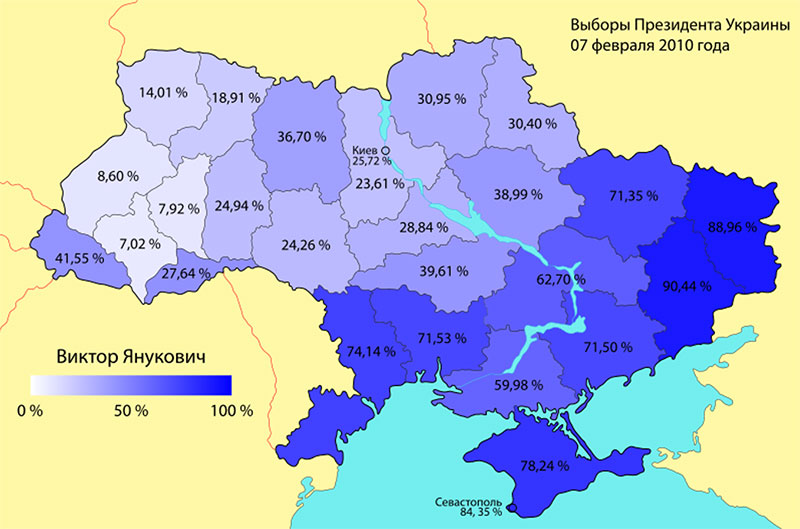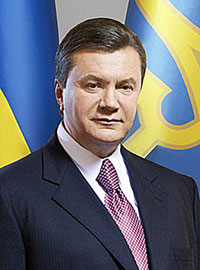The 2014 Maidan Revolution


According to Eric Zuesse, writing in Strategic Culture (September 5, 2016), in 2011, Secretary of State Hillary Clinton was tasked by President Obama to overthrow the democratically elected President of Ukraine, Viktor Yanukovych, and Syrian President Bashar-al-Assad in Syria by means of “color revolutions.” Color revolutions are opportunistic regime changes by “popular revolutions,” which are clandestinely planned, directed, and financed by CIA sources, often assisted by the British MI6 foreign intelligence services. The CIA Director at that time was John Brennan. John Kerry replaced Hillary Clinton as Secretary of State in February 2013. The objective of such color revolutions is supposedly to spread the rule of democratic government.
This planning for Ukrainian and Syrian regime changes occurred concurrently with the Arab Spring revolutions, in which huge public protests challenged established governments. This began in Tunisia, but the most important was the Muslim Brotherhood backed overthrow of Egyptian President Hosni Mubarak on February 11, 2011, a key U.S. ally for 25 years. An uprising against Libyan leader Muammar Ghaddafi, who had ruled for 42 years, began on February 15 in Benghazi. American, French, and British forces intervened against Ghaddafi in the resultant civil War, and Ghaddafi was captured and killed by rebels on October 20. In my opinion, President Obama’s Middle East foreign policy in 2011 was closely tied to that of the Muslim Brotherhood. The next step was Syria, in which Muslim Brotherhood allied al-Qaeda terrorists operated under such democratic sounding names as the “Free Syrian Army.” The radical Islamic Muslim Brotherhood had long hoped to overthrow the minority Alawite Muslim regime of the Assad family, which was so moderate that it did business with and protected the Orthodox Christian minority in Syria. The radical Muslim Brotherhood has global ambitions for power and has posed a threat to the United States, the United Arab Emirates, and even Saudi Arabia.
Also according the Zuesse, the first “technical camp” for training mass-demonstration organizers in Ukraine was held on March 1, 2013, in the U.S. Embassy in Kyiv. American instructors showed how social networks and internet technologies could be used to manipulate public opinion and provoke violent protests. Examples of successful network formation in Egypt, Tunisia, and Libya were used. By the last conference in the Kyiv Embassy in November 2013, 300 organizers had been trained in five training conferences throughout Ukraine. A considerable amount of the funding came from George Soros sponsored organizations.
In November 2013, Ukrainian President Viktor Yanukovych, who had been elected in 2010, set aside a parliamentary approved decision to join the European Union to consider a more attractive offer from the Russian led Eurasian Economic Union (EAEU). This included cheap natural gas and a badly needed $15 billion loan to heal the Ukrainian economy. The EU could not compete with the offer. This anticipated reversal caused a series of street protests that lasted for months. More restrictive protest laws and police enforcement led to a large, barricaded protest camp on Independence Square (Maidan) in central Kyiv, giving the “Maidan Revolution” name to the pollical demonstrations.
On January 1, 2014, a torchlight parade in Kyiv celebrated the 105th birthday of Ukrainian nationalist and Nazi collaborator Stepan Bandera. The parade was strongly associated with the Ukrainian Svoboda (Freedom) Party.
On February 6, U.S. State Department NATO Ambassador, Victoria Nuland, met with the leaders of the Svoboda (Freedom) Party, which is generally considered ultranationalist and strongly anti-Russian. Many of its members have strong historical sympathies with Stepan Bandera. They are strongest in Western Ukraine and had often been associated with thuggish protest mobs. They are a small party, winning just 11 percent of seats in the 2012 Parliamentary Elections but have considerable influence over more centrist Ukrainian parties. Conservapedia estimates from two to five thousand activists in the Maidan demonstrations were members of the Svoboda Party.
During February 18-20, the Maidan Revolution began in which 100 activists, many paid by George Soros, and 17 police officers were killed. According to the Prosecutor General’s office, more than 150 witnesses, including more than half the wounded, testified that snipers from overlooking buildings, including Hotel Ukrainia, began shooting at both police and activists allegedly to enlarge the disaster and magnify the national and international protest against Yanukovych. All the deadly sniping reports were denied by the post-revolution investigating committee. George Friedman, chairman of Stratfor, called the Ukrainian coup "the most blatant coup in history.
According to a Reuters news article on March 3, Vice President Joe Biden called Yanukovych for the second time in three days on February 20, warning him that he must call back his security forces and submit all issues to a European settlement committee or be held accountable. Speaking to Yanukovych for nearly an hour, Biden warned him: “It Will catch up with you.” According to the Reuters report, within hours, Yanukovych signed a deal with the opposition and fled the country. Yet they still issued a warrant for his arrest, charging him with murder.
The opposition may have been the leaders of Parliament, who officially removed Yanukovych from office without discussion or trial with a “yes” vote of all 328 of the largely traumatized and fearful members present, although this was just 73 percent of the 450 membership that needed a 75 percent quorum. Procedurally, Yanukovych’s ouster was unconstitutional. Yanukovych later protested this and alleged that the Svoboda Party had orchestrated and railroaded his removal.
The day after Yanukovych fled Ukraine, Crimea, which is predominantly Russian, requested the Russian Federation to annex them. The two Donbas oblasts, Donetsk and Lugansk, requested the same. Crimea is only about 15 percent Ukrainian and has never been more than 25 percent Ukrainian. The Russian Duma immediately accepted Crimea’s request. Russian troops were already based on Crimea by treaty, and more were sent by Moscow. Most of the Ukrainian troops there went over to the Russians. Only six people died. A Crimean referendum approved the annexation with 97 percent favorable votes.
The Donbas oblasts were turned down by the Duma. The reasoning may have been that the heavily pro-Russian vote in the Donbas region could maintain enough political leverage to prevent Ukraine from becoming an anti-Russian bulwark for NATO. That sentiment would later change because of the harsh treatment of the large Russian minority in Ukraine by the new Ukrainian government and the Ukrainian Army. This treatment amounted to severe cultural discrimination and ethnic cleansing, in some cases, as in Odessa, mass murder of more than 42 Russian ethnic protestors. The Donbas oblasts declared themselves independent republics.
Hunter Biden was appointed to the Burisma Oil and Gas Board of Directors on April 14, 2014. In March 2016, Joe Biden, leveraging a billion dollars of aid to Ukraine, insisted that the chief Ukrainian Prosecutor Viktor Shokin be fired. Was it because he was investigating Burisma and possibly Hunter Biden?
Parliamentary leader Oleksandr Turchynov became interim President until the May elections. Petro Poroshenko, a billionaire oligarch, was elected with 55 percent of the vote.
Poroshenko declared an anti-terrorist war on the Donbas Republics in May 2014 and sent Ukrainian Army troops and artillery to smash the Donbas Republics. Ukrainian artillery did not spare Donbas civilians. Over 14,000 people died in the Donbas conflict between April 2014 and February 24, 2022. Most of them were Russian ethnic civilians. Russia felt compelled to help its ethnic compatriots with supplies, arms, and volunteers for the Donbas militias.
Talks and a cease-fire began in September 2014, and the Minsk agreements in February 2015, brokered by France and Germany, promised that Ukraine would treat Russians as equal citizens, refrain from cultural cleansing, and implement autonomous status for the Donbas Republics within Ukraine. However, Ukraine continued to delay implementation, and heavy fighting resumed in early 2017 and continued for five years. Ukrainian President Zelensky finally rebuked the signed Minsk agreements on February 18, 2022.
Putin and most Russian historians view Russians and Ukrainians as one people divided by political and geographic borders. In fact, many Ukrainians live in Russia, and a sizable Russian population lives mostly in southern and eastern Ukraine. As the saying goes, “Scratch a Russian, and you may find a Ukrainian grandmother. Scratch a Ukrainian and you may find a Russian uncle.” There are many Russian-Ukrainian couples and families. The current Ukrainian government, however, tends to emphasize the distinctiveness of Ukraine.
Looking at language can give us some truth. Both Ukrainian and Russian are East Slavic languages. Russian and Ukrainian have 62 percent lexical similarity. That is that 62 percent of the vocabulary of both languages is similar. Ukrainian is closest to Belarusian with 84 percent similarity. The lesser similarity of Russian is primarily due to Peter the Great bringing so many French words into Russian. Both languages use the Cyrillic alphabet with a few differences.
About 60 percent of Ukrainians consider Ukrainian their mother tongue. Close to 18 percent consider Russian their mother tongue. An amazing 22 percent consider both Russian and Ukrainian their mother tongue. Most people in Ukraine speak Russian at least as a second language.
Even their DNA is very close. The most common Y-DNA among Russian males if the Slavic R1a type with 46 percent. Ukraine is 44 percent R1a. They differ somewhat in minority DNA types. The next largest to R1a in Russia is the Finnic N1c type. In Ukraine, the second largest is I2a with 21 percent, most common in Slavic speaking areas of Southeastern Europe.
Christian identity has risen sharply since the fall of Communism in 1991, and both Russia and Ukraine are predominantly Orthodox Christian, although Ukrainian politicians have tried to put a wedge between Russian and Ukrainian Orthodox Christianity. Amazingly, Joe Biden was a key factor in promoting this division in September 2018.
Ukrainian political differences have a strong correlation with Ukrainian or Russian cultural orientation. The Russian side is usually identified with Russian language and the Russian Orthodox Church. At least 40 percent of voters are strongly oriented to Russian culture and politics.
Although Viktor Yanukovych was Russian oriented, he won the 2010 Presidential Election with 49 percent of the vote. Sixty to ninety percent of the voters in Crimea and 8 other southern and eastern oblasts voted for him: Donetsk 90%, Lugansk 89%, Crimea 78%, Odessa 74%, Zaporizhia 72%, Mykolaiv 72%, Kharkiv 71%, Dnepropetrovsk 63%, and Kherson 60%. These correspond to Russian primary language percentages of 50 to 90 percent. Yanukovych got only 7 to 19 percent in five western Ukraine oblasts.
Following the Maidan Revolution, the U.S. and other NATO allies built and trained the Ukrainian Army into the largest of any European NATO army except Turkey. The Russians have identified at least 30 Ukrainian biological warfare labs built by the U.S. According to retired Army Colonel and Virginia State Senator Richard Black, the number is actually 44.
So was the Russian invasion of Ukraine unprovoked or did the U.S. and NATO allies poke the Russian Bear beyond reasonable tolerance? What are American objectives, and are they realistic and honorable? What has it cost in Ukrainian lives and Ukraine’s economic future? Are we playing Russian Roulette with World War III?